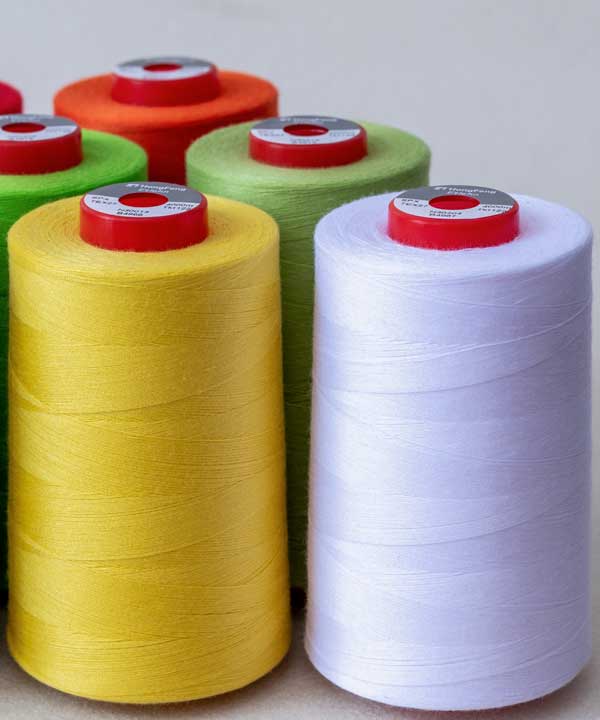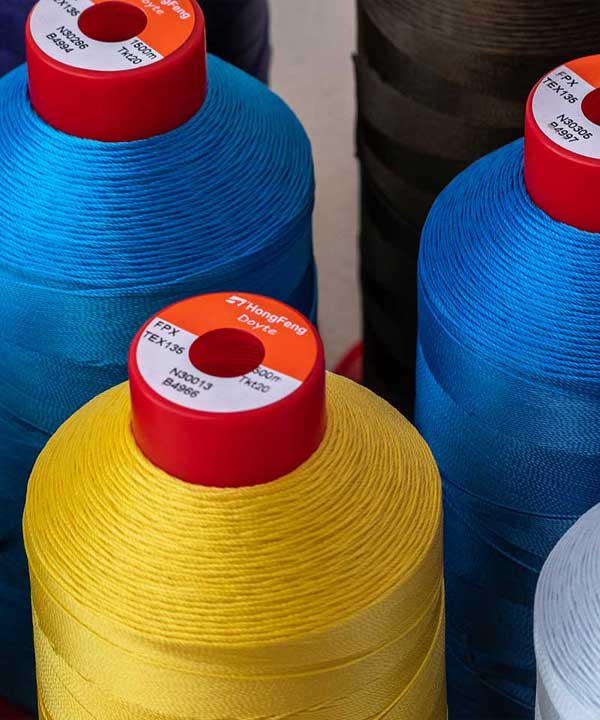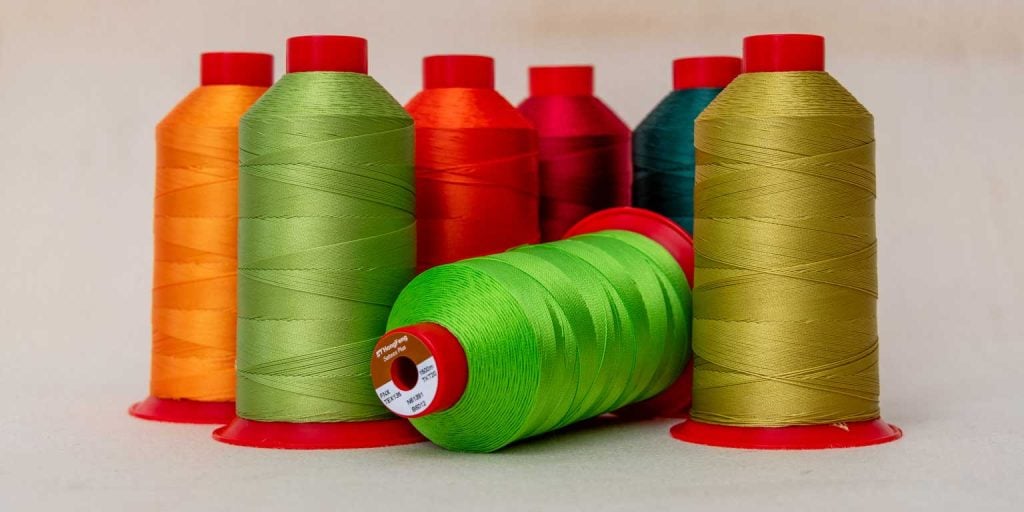The polyester threads may all look the same, except for the color difference. Before you buy or use thread for your next project, a look at the different aspects of thread quality will make your crafting experience better. A deeper look at the difference between Staple Spun Polyester Threads and Continuous Filament Polyester Threads will help you make the best selection for your project.
Table of Contents
Polyester Yarns
The fundamental utilization of Polyester has been in the textile field for making Polyester Yarns.
Polyester in various structures is utilized broadly as a part of textile application to make polyester (PET) resin and Filament Yarn, for example, Partially Oriented Yarn (POY), Polyester Drawn Textured Yarn (DTY), Polyester Fully Drawn Yarn (FDY), Polyester Staple Fiber (PSF), Polyester Spun Yarn (PSY), Technical Yarn, Tire cord and Mono filaments Yarn.
Polyester fibers recover quickly after extension (the term elongation describes the stretch and recovery) and absorb very little moisture. Polyester is heat resistant (dryer and iron safe), with a melting temperature of about 480º F (in comparison, nylon starts to yellow at 350º F and melts at about 415º F). Polyester fibers are colorfast, resistant to chemicals, and can be washed or dry-cleaned with most common cleaning solvents.
Read More: Polyester Wikipedia
What is Filament Polyester?
Filament Polyester, also known as continuous filament polyester, is a type of polyester fiber form. Polyester filaments are long strands of continuous length. In the polyester manufacturing process, the spinning fluid is continuously extruded from the spinneret holes, cooled by air, or solidified in a coagulation bath to form continuous filaments, then processed by stretching and twisting, or deformation. process for further processing applications. The filaments thus obtained can be divided into monofilaments and multifilaments with a length of several kilometers or tens of thousands of meters.
What is Spun Polyester?
Spun Polyester is a fiber obtained by spinning polyester (that is, polyethylene terephthalate, PET for short, which is polymerized by PTA and MEG) and then cutting it into two. Spun Polyester is divided into cotton staple fiber and wool type.
Polyester staple fiber is mostly used for spinning, such as making wool, weaving, and fiber fills to stuff pillows, cushions, sofas, and beddings.
Types of Filament Polyester
Polyester filaments can usually be divided into three categories: POY (pre-oriented yarn), FDY (full-drawn yarn) and DTY (low elastic yarn). POY is mainly used for post-processing production such as the production of DTY, DT, ATY, and can also be directly used in the silk textile industry.
FDY is mainly used in clothing and textile industries; DTY is an ideal raw material for knitting (weft knitting, warp knitting) or machine weaving, suitable for making clothing fabrics (such as suits, shirts), bedding (such as quilts, bedspreads, mosquito nets) and Decorative items (such as curtain cloth, sofa release, wall covering, car interior decoration cloth), etc.
Read More: Thread for Sewing Machine

Spun Polyester Sewing Thread
Made of 100% polyurethane polyester staple fiber, it has high strength and is mainly used for industrial sewing of denim, sportswear, leather products, wool, and military uniforms. It is the most widely used and popular sewing thread at present.
4 Basic Knowledge of Spun Polyester Sewing Thread
- Knowledge 1 – features: It has high strength, good elasticity, wear resistance, low shrinkage and good chemical stability. There are hairs on the surface, the temperature resistance is 130 degrees, and it can be dyed at high temperature.
- Knowledge 2 – advantage: Polyester raw material is the most resistant to friction, dry cleaning, stone grinding, bleaching and other detergents among all materials. It has low elongation and low stretch rate, and has the characteristics of flexibility, fit, full color and good color fastness. , ensures excellent seamability and prevents wrinkles and skipped stitches.
- Knowledge 3 – application: It is mainly used for industrial sewing of denim, sportswear, leather products, woolen materials and military uniforms. It is the most widely used and popular sewing thread at present.
- Knowledge 4: classification: Staple sewing thread is often expressed in the form of [yarn count/strand number], for example: 20S/2, 20S/3, 20S/4, 30S/3, 30S/2, 40S/2, 40S/3, 50S /2, 50S/3 60S/2, 60S/3, etc.
Read More: Filament Sewing Thread
Etlehn® Staple Spun Poyester Sewing Thread Parameters
| Tex | Tickets | Specification | Averages | Strong | Elongation Min-Max |
| (T) | (TKT) | (s) | (cN) | (g) | (%) |
| 18 | 180 | 60/2 | 666 | 680 | 12-16 |
| 24 | — | 50/2 | 850 | 867 | 12-16 |
| 30 | 120 | 40/2 | 1020 | 1041 | 13-17 |
| 30 | 120 | 60/3 | 1076 | 1098 | 12-16 |
| 40 | 80 | 30/2 | 1340 | 1379 | 13-17 |
| 45 | 75 | 40/3 | 1561 | 1593 | 12-16 |
| 60 | 50 | 20/2 | 2081 | 2123 | 13-18 |
| 80 | 30 | 20/3 | 3178 | 3243 | 13-18 |
Read More: High Quality Staple Spun Polyester Sewing Thread

High-strength Filament Polyester Sewing Thread
It is made of high-strength and low-elongation polyester filament (100% polyester chemical fiber), which has the characteristics of high strength, bright color, smoothness, acid and alkali resistance, wear resistance, corrosion resistance, and high oiling rate. Nylon thread is hard and will emit black smoke when burned.
Types
Filament Polyester Sewing Thread is often expressed in the form of [Daniel/strand number], such as 150D/2, 210D/3, 250D/4, 300D/3, 420D/2, 630D/2, 840D/3, etc.; Japan, Hong Kong, Taiwan, and other countries and regions usually use numbers such as 60#, 40#, and 30# to indicate thickness. Generally, the larger the numerical table, the thinner the line, and the smaller the strength.
Doyte® Filament Polyester Sewing Thread Parameters
| TEX | METRIC | LENGTH | RA (dTex) | BSA (cN) | EBA | DHS 150℃(%) | BWS 100℃(%) |
| 10 | Tkt 250 | 5,000M | 130 | 630 | 20 | <2.5 | <1.0 |
| 12 | Tkt 200 | 3,000M | 183 | 920 | 19 | <2.5 | <1.0 |
| 18 | Tkt 180 | 5,000M | 180 | 920 | 21 | <2.5 | <1.0 |
| 24 | Tkt 120 | 3,000M | 254 | 1420 | 19 | <2.5 | <1.0 |
| 30 | Tkt 080 | 2,000M | 373 | 2170 | 18 | <2.5 | <1.0 |
| 50 | Tkt 060 | 2,000M | 576 | 2620 | 18 | <2.5 | <1.0 |
| 60 | Tkt 040 | 3,000M | 783 | 4230 | 17 | <2.5 | <1.0 |
| 90 | Tkt 030 | 2,000M | 943 | 5200 | 19 | <2.5 | <1.0 |
| 135 | Tkt 020 | 1,500M | 1596 | 8360 | 19 | <2.5 | <1.0 |
| 150 | Tkt 018 | 1,500M | 1840 | 9030 | 22 | <2.5 | <1.0 |
| 180 | Tkt 015 | 1,000M | 2286 | 11400 | 22 | <2.5 | <1.0 |
| 270 | Tkt 010 | 900M | 3405 | 16630 | 23 | <2.5 | <1.0 |
| 350 | Tkt 008 | 700M | 3856 | 19480 | 28 | <2.5 | <1.0 |
RA: Roughness Average. BSA: Breaking Strength Average. EBA: Elongation at Break Average. DHS: Dry Heat Shrinkage. BWS: Boiling Water Shrinkage
Read More: Best CF Polyester Flinament Thread for Sewing Machine
Staple Spun Polyester Threads vs Continuous Filament Polyester Threads
Staple Spun Polyester threads are manufactured from high tenacity staple fibers. A typical high tenacity fiber used for sewing thread would be 1.2 denier, which is a measure of the linear density and 38mm long with a tenacity of at least 7.5 grams per decitex. Some thread producers use a fiber length of 45mm or even 55mm depending on the machinery they have available. SSP threads are produced in a wide range of constructions and sizes, tex and ticket numbers, to accommodate most general sewing applications.
- Continuous Filament Polyester Sewing Threads produced by Hongfeng are made from 100% High-Quality Filament Polyester.
- Continuous Filament poyester threads are significantly stronger than their equivalent size in Corespun, SSP (Staple Spun Polyester) or Cotton. Continuous Filament Polyester Sewing Threads are used in sewing applications where the seam strength is particularly important such as footwear and fine leather goods.
- If you feel some type of fuzz around your thread, this indicates it was produced with short fibers and is considered a weak thread.
Four of Continuous Filament Polyester Sewing Threads
- Soft CF(Continuous Filament) Polyester Thread: Which is the simplest form. In the production of a continuous filament yarn the filaments are gathered from the spinneret into a continuous strand, each strand comprising a specific number of filaments dependant on the desired characteristics.
- Soft CF(Continuous Filament) Polyester Thread: These strands are then combined and twisted conventionally into plied constructions similar to the post spinning processes used for spun threads.
- Bonded Polyester Thread: In this case, the threads are coated with a soluble resin Polyurethane for Continuous Filament Polyester. After application, the resin is cured and dried which has the effect of holding the plies together. The application of the bonding agents also reduces the abrasion on the thread during the sewing operation.
- Corespun polyester threads are a combination of a filament polyester core thread wrapped in spun polyester. It is also known as ‘Poly-core spun-poly’, “P/P”, and “PC/SP” thread. The benefit of using a core spun polyester thread like OMNI or OMNI-V, is the added strength that the filament core adds. OMNI and OMNI-V are favorites for quilting with their matte finish and strong tensile strength.
- Trilobal Polyester: It is a specific type of Continuous Filament Polyester mainly used for embroidery thread.
Works Cited: Thread Production 101


